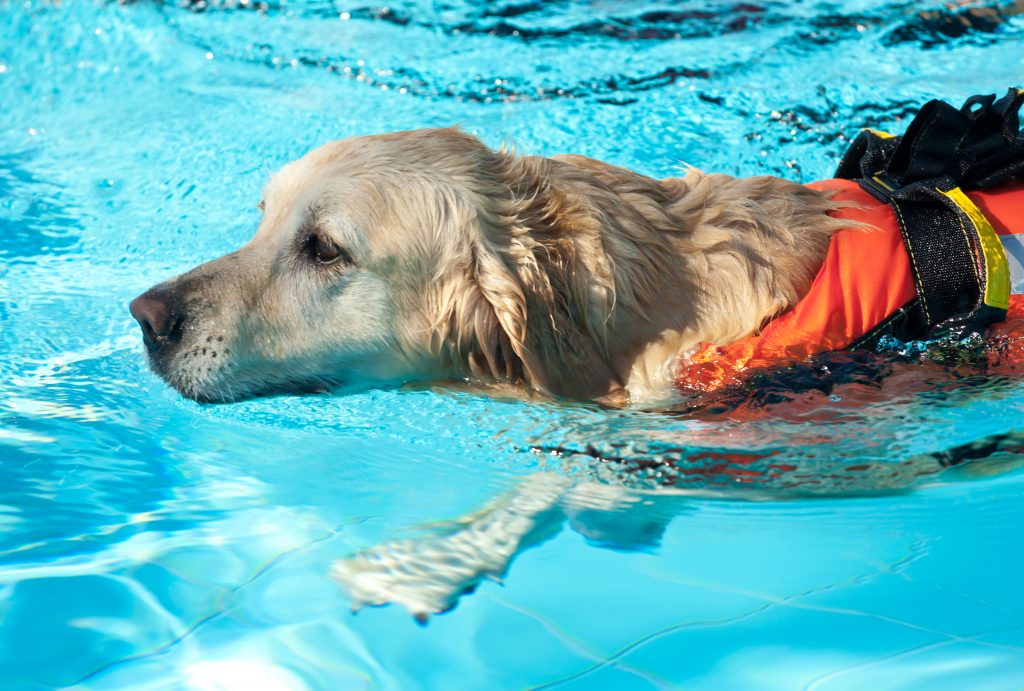![HappyAd [CC BY-SA 4.0 (https://creativecommons.org/licenses/by-sa/4.0)] Hydrotherapy for dogs](https://www.saratogadoglovers.com/wp-content/uploads/2020/01/dog-hydrotherapy-e1577932549927.jpg)
Hydrotherapy for humans has been around for centuries, and now it’s becoming a popular healing tool for dogs too! More vets are recommending hydrotherapy for dogs as an effective way to help treat joint disease, rehabilitate dogs after surgery, and help obese dogs lose weight. Many owners are using water therapy for dogs as an alternative to traditional treatments such as medications, some of which have harsh side effects.
What Is Hydrotherapy for Dogs?
Hydrotherapy for dogs involves moving and exercising in water, providing low impact physical therapy techniques. Heated to a temperature of about 85 degrees, the warm water used in dog hydrotherapy helps to promote blood flow and relax a dog’s muscles. When a dog’s muscles are relaxed, he can move easier and more comfortably.
Types of Hydrotherapy Pools For Dogs
There are a number of types of hydrotherapy pools used for dogs depending upon the exercise and therapy needs of each animal.
Underwater Treadmills
The most popular type of hydrotherapy for dogs uses an underwater treadmill. Underwater treadmills are becoming more common in traditional veterinary practices, and most veterinary rehabilitation clinics offer them as well. An underwater treadmill consists of a treadmill enclosed in a water-tight tank. After a dog climbs a ramp into the tank, the tank is closed and fills with water to a level just above the dog’s legs. Then the dog walks on the treadmill while a therapist monitors the dog’s movements through the clear sides of the water tank.
Whirlpools
Another type of dog hydrotherapy uses whirlpools. Like the hot tubs that many people use, dog whirlpools have water jets that are effective for massaging muscles. In addition, a dog whirlpool is outfitted with a hoist and a harness for lifting and lowering dogs in and out of the water.

Dog Hydrotherapy Pools
Dog pools are also sometimes used in dog hydrotherapy. Unlike traditional swimming pools, many dog hydrotherapy pools have a current that offers resistance for dogs as they exercise. Dog pools are used for swimming, agility exercises, diving to fetch, strength exercises, and flexibility exercises. And dog pools offer quite a workout. A 5 minute swim in a dog pool is the exercise equivalent of a 5 mile run on land! Dog pools can even help dogs that are not natural-born swimmers. A harness or a life vest is used until a dog shows that he is comfortable in the water.
Hydrotherapy: Healthy, or All Washed Up?
Why are so many vets and dog owners turning to hydrotherapy? Because of all the health benefits! Hydrotherapy is great because it allows a dog to exercise without the impact of repeatedly stepping onto a hard surface.
- Low impact exercise means less stress on a dog’s joints. And water makes a dog’s body buoyant, which means the weight of a dog’s body is supported when he is submerged. Therefore, the dog is not fighting gravity as he works out.
- Hydrotherapy also helps reduce inflammation, pain, and mental stress in dogs. The warm water used in hydrotherapy reduces swelling in tissues and joints. And when warm water increases skin temperatures, it relaxes muscles, which decreases pain. As for stress, water can even soothe and calm a dog’s nervous system.
- A dog’s muscles benefit from hydrotherapy too. Water offers resistance that is 15 to 20 times greater than the resistance of working out in air. And when currents are used in dog pools, the resistance is even greater. Why does resistance matter? Because it tones and strengthens a dog’s muscles, and it increases endurance. Resistance is also what makes hydrotherapy an effective cardiovascular workout, which improves a dog’s overall fitness.
- The health benefits don’t end there. Because hydrotherapy increases circulation, it can improve a dog’s skin and coat. The hydrostatic pressure from water aids lymph drainage, which helps rid a dog’s body of toxins and improve his immune system.
- Water therapy also helps a dog to breathe deeper, which can improve his respiratory health. Even a dog’s digestive system can benefit from hydrotherapy because water can increase the activity of smooth muscles, like the ones in a dog’s digestive tract.
Should Your Dog Take the Plunge?
Hydrotherapy can help many different health issues in dogs. Dogs with joint problems such as hip dysplasia, arthritis, and degenerative joint disease are good candidates for hydrotherapy. The buoyancy of water, combined with the resistance it offers, makes hydrotherapy a safe alternative to weight bearing exercises outside of water.
Hydrotherapy is also helpful for dogs following surgery and traumatic injuries. Many rehabilitation programs now incorporate hydrotherapy because it can help improve the rate of healing and increase the chance that a dog will have a full recovery. Likewise, hydrotherapy can be a helpful part of the rehab process for dogs suffering from neurological disorders or injuries such as those affecting the interverterbral discs.
In addition, obese dogs can benefit from hydrotherapy. Because hydrotherapy offers a great cardiovascular workout, it can be used as part of a weight loss program. Senior dogs, working dogs, pre-operative dogs, dogs with paralysis, and competition dogs can all enjoy improved health with hydrotherapy. And hydrotherapy is a great way for fit dogs to stay in shape!
Sign Me Up!
If you think hydrotherapy can help your dog, you should consult your vet. A few dogs may not be good candidates for hydrotherapy, particularly if they have swallowing problems, ear problems, incontinence, or skin conditions that can be aggravated by exposure to water.
Your vet can refer you to a reputable hydrotherapy clinic. Even though dog hydrotherapy equipment can be purchased for use in your home, hydrotherapy works best when administered by a professional. Why? Because hydrotherapy can be dangerous in post-operative dogs and dogs with health challenges when they are not monitored by experienced technicians.
Good hydrotherapy programs have licensed professionals, safety procedures, clean facilities, and staff members who are gentle and kind with dogs. You may also want to check out the type of water a hydrotherapy clinic uses. Some facilities used chlorinated water, which can be harsh and drying to your dog’s skin, while others use salt water, which has therapeutic properties.
Are you on a budget? You may want to consult with your pet insurance provider because hydrotherapy for your dog can be expensive.
Are you a hands-on dog parent? Some hydrotherapy clinics will let you participate in your dog’s therapy and even join him for playtime in the pool!
Most dogs can benefit from hydrotherapy. You may find that a few weeks of hydrotherapy are all that your dog needs to get in shape, or you may decide that hydrotherapy can help your dog for the rest of his life. But either way, your dog will surely feel better when you promote his good health with hydrotherapy!
You may also like:
